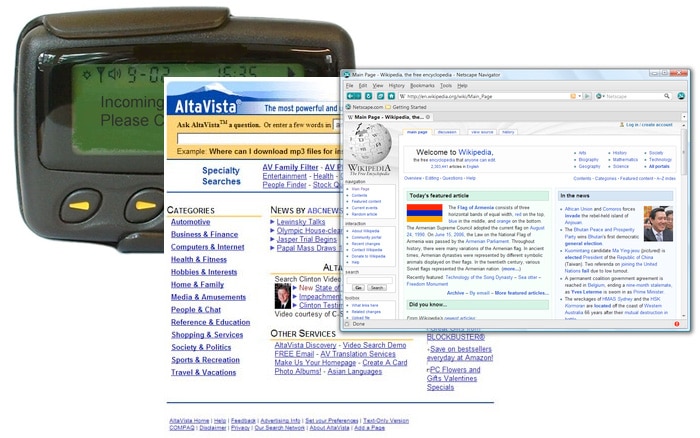Web Hosting (1999 – 2010)
Twenty-some years ago, when I got into the web development game, it has been that long! It was the days of Netscape and Internet Explorer (on the Mac). Firefox and Chrome, let alone the mobile web, wasn’t even a thing.
We sported flip phones clipped to our belts, and I even had a pager to alert me when websites and servers went down, which was often. Only a few of us had started using Google, and others still swore by Yahoo, AltaVista, HotBot, or even Ask Jeeves!

Web Servers Cost Hundreds of Thousands
It was the early 2000’s and servers cost hundreds if not thousands of dollars a month, the big “daddy” hosting companies were just getting started, and hosting was just plain expensive.
Web Servers were Reliably Unreliable
 Not only was it expensive, but they were unreliable. Remember Windows 95 and XP, and how often you had to restart those monsters?
Not only was it expensive, but they were unreliable. Remember Windows 95 and XP, and how often you had to restart those monsters?
Web servers were not much better. We weren’t as worried about speed back then as we were about whether the website was up and running.
Web servers would crash at the slightest uptick in traffic or randomly, which seemed the most common cause. I cannot tell you how many weekends and evenings were ruined by down servers!
In particular, I remember an all-nighter on a Hawaii vacation because of a crashed hard drive on one of our servers back in Virginia.
That’s It! No More Web Hosting Services
At a point in my career, I decided I couldn’t deal with hosting anymore, and I got rid of that part of my business. Shuffling all my clients to GoDaddy, Bluehost, and others.
Lesson learned: clients still called me when their site was down or had web host-related problems. I hated hosting even more!
Web Hosting (2010 – 2020)
A Web Support Company Has to Provide Hosting, right?
When I started FatLab, LLC a little over twelve years ago, I knew if I was going to create a “website maintenance company,” I would have to offer a good hosting solution to my clients and not simply brush them off as a cheap plan that would make both our lives hell.
Web Servers Were Reliably Mostly Reliable
By this time, web servers had become a little more stable, hard drives more reliable, and networks larger, but websites had also gotten much more complicated.
Load Time Was Now a Real Factor
Google, by now, was very much the de facto search engine and had announced that the speed of a website’s load time was going to be a ranking factor. Even before people understood that the search engines cared about load time, they cared, and now calls were not just about downtime but load time.
Building a Mostly Reliable Web Hosting Platform in 2010
Wanting to offer a premium service, I partnered with Rackspace and spent a small fortune on redundant load-balanced web servers with replicated databases. Hosting was better then.
Redundancy Was Key
 I remember one flight between Costa Rica and Houston, TX. We just touched down, and I turned on my phone, ding, ding, ding, ding, ding... the alerts came flowing in.
I remember one flight between Costa Rica and Houston, TX. We just touched down, and I turned on my phone, ding, ding, ding, ding, ding... the alerts came flowing in.
Our primary web server had gone down while I was in flight. However, our secondary server had stayed up to deliver traffic, and the final text message alerted me that the Rackspace team had also gotten alerted and resolved the crashed primary server. This felt great; hosting was OK!
… Almost…
A couple of years later, I flew from Costa Rica to London for a family vacation. After crossing the Atlantic, I got into the airport and connected to Wi-Fi; ding, ding, ding, ding, ding… the alerts came flowing in. Damnit!
Was the answer to this problem never to get on a plane again?!
There is Always a Single Point of Failure
This time the load-balancer had crashed. Despite all our replication and redundancy, the load-balancer was a single point of failure because ALL traffic had to go through the load-balancer before it was sent to the duplicated, redundant, fallback, fail-safe setup behind it.
Hosting was still hell, ruining my vacations and killing me slowly with stress.
Again, I thought, I have got to get rid of managed web hosting as a service because this sucks!
Web Hosting (2020 – 2022)
About two years ago, we retired the load-balanced, fallback, redundant complexity we had set up with Rackspace. We began moving our clients back to single-server solutions.
You may be asking why on earth I had decided to move away from the more complex and seemly more reliable setup. The answer is simple. Over the last eight years, technology had improved, gotten cheaper, and become more accessible:
- Server reliability had improved greatly
- Hard drives had gone to solid-state from less reliable spinning disks
- Server security had improved greatly
- We added a firewall as part of our standard service, which significantly reduced the server load
- We started using CDNs for all our clients, which reduced the average server load even further
- Server memory and CPU usage had improved
- Databases and web servers had gotten faster while becoming more efficient
- The cost of services like web application firewalls and CDNs had dropped significantly and were easier to setup
- Virtual machine technology had dropped the price of machine resources
- Management companies were taking over server management for pennies on the dollar compared to when I started this adventure
- Caching technologies have become less cumbersome and more automated
Now instead of having two servers in Dallas, we have 6-8 in New York, Miami, Seattle, Dallas, Chicago, and other places. The servers are spread out geographically and on different networks and providers.
Reliable Hosting in 2023
 Today we are a Gold Agency Partner of Cloudways, and I haven’t looked at the server terminal in months.
Today we are a Gold Agency Partner of Cloudways, and I haven’t looked at the server terminal in months.
I can deploy new websites with a click of a button, issue SSL certificates with a push of a button, set up staging sites with a push of a button… you get the idea.
Any time there is a server issue, I can call a technical team, and thanks to improvements in technology, what used to take hours for server techs to diagnose and resolve now takes minutes most of the time.
Things that used to take hours or even days to get set up are now push-button:
- SSL certificates (LetsEncrypt)
- Web Application Firewalls (Cloudflare Enterprise is now built into our hosting platform)
- CDNs (now included as part of our firewall solution)
Things that used to be cost-prohibitive even for our largest clients:
- Dedicated servers or server resources
- Firewalls
- CDNs
What This Means for FatLab
It means that hosting has gone from being something we sold out of necessity to support clients to something we are proud to offer.
It means that instead of focusing on uptime, we can focus on performance and security for our clients. It means I have not had an interrupted evening, weekend, or vacation in years, and I can reliably assure my clients that their sites will be up, secure, and performing.
Can you believe our servers today are actually “self-healing”?
Web Hosting Has Become a Primary Offering for Us
I often tell our clients that it’s not the hosting we are selling them because you can get that for like $5/month somewhere else; what we are selling is the management services.
We are providing them with a performance and service-based solution where we are responsible for the entire environment. No one has to wait on hold for an hour just to be told they must call a web developer and get hold of a web developer to be told it is a hosting issue.
The last20+ years have been a real adventure and as I look back, I see a company and individual (myself) always improving what is being offered. We don’t stick with the old services just because they work; we find the best solutions and give those to our clients. I’m proud of that.
The biggest thing our clients get is someone who gives a s*** if their site is down. You are not going to get that from a big hosting company.
Go Ahead and Nerd Out a Little
Here is our current technology stack:
Hosting: Vultr, Digital Ocean, Amazon, and Google
Server Management: Cloudways
Firewall: Cloudflare Enterprise or Stackpath
CDN: Cloudflare Enterprise
SSL: Let’s Encrypt
Backups: Cloudways and ManageWP
Website Updates: ManageWP
Uptime & Performance Monitoring: StatusCake, Cloudways, and ManageWP
On-Site Image Optimization: Imagify and Cloudflare
On-Site Cache and Performance Management: Breeze.
That package above could easily run a single site owner for $300-500.
What we have put together is a hell of a package backed by our (great) support services.
We don’t charge by the megabyte or the gigabyte, not having to guess how many resources you need; we give each site enough resources to perform well. If it needs more, we add more. For those clients that have special requirements, we offer dedicated servers (VPS) with IP whitelisting and other configurations to allow more complex solutions to run with ease.
Today I have a very different relationship with web hosting than 20, 10, or even two years ago!





